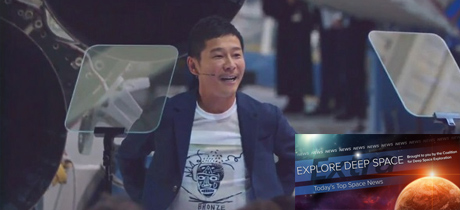In Today’s Deep Space Extra… NASA’s return to the Moon with U.S. astronauts will prepare the technologies and capabilities necessary for the human exploration of Mars, Administrator Jim Bridenstine tells the annual AIAA Space Forum gathered in Orlando this week. SpaceX founder Elon Musk presents Japan’s Yusaku Maezawa, a wealthy clothing manufacturer who is prepared to pay to launch around the Moon on a Big Falcon Rocket (BFR).
Human Space Exploration
Coalition Board of Advisor in the News – Dr. Tom Jones
Aerospace America (September): Former NASA shuttle astronaut and planetary scientist Dr. Tom Jones offers a walk-through of preparations at NASA’s Kennedy Space Center (KSC) for the respective 2020 and 2022 launches of the space agency’s Exploration Mission-1 (EM-1) and Exploration Mission-2 (EM-2), the first uncrewed and crewed missions of the Space Launch System (SLS) and Orion crew capsule around the Moon and back to Earth. Each will also team the European Space Agency’s service module with Orion.
NASA head doubles down on agency’s mission: ‘It’s time we go back to the Moon’
Orlando Sentinel (9/17): NASA Administrator Jim Bridenstine championed NASA’s return to the lunar environs with human explorers Monday as he addressed the opening of the AIAA’s three day annual Space Forum in Orlando. NASA will pursue reusable technologies and mature the systems needed to move out on the human exploration of Mars, while working with the U.S. private sector and international partners at the Moon, said Bridenstine..
Houston Chronicle (9/17): The Houston home to NASA’s Orion program as well as the agency’s astronaut corps and Mission Control is preparing a mockup of the Orion crew capsule for a critical test flight planned for April 2019 at NASA’s Kennedy Space Center (KSC). The short flight will test the ability of the capsule’s abort system to propel Orion and its crew to safety in the event of a problem with the Space Launch System (SLS) launch vehicle. The 2019 will be conducted without astronauts on board.
Space Science
The closest planet ever discovered outside the Solar System could be habitable with a dayside ocean
Universe Today (9/17): Just over two years ago, astronomers affiliated with the European Southern Observatory confirmed the presence of an Earth like planet around the nearest star, Proxima Centauri. The planet, Proxima b, orbits in the habitable zone, a region where if water is present on the surface, it would be stable as a liquid. However, subsequent observations were not so encouraging, based on the star’s instability. However, a new NASA led assessment suggests water may be present on Proxima b in spite of the star’s excessive flare activity.
NASA’s TESS shares first science image in hunt to find new worlds
NASA/Goddard (9/17): Launched in April, NASA’s extra solar planet hunting Transiting Exoplanet Survey Satellite (TESS) has been positioned and checked out. Recently, it provided scientists with a “first light” science image of stars in the southern sky.
Interplanetary umbrella: New heat shield could land bigger payloads on planets
Space.com (9/17): NASA is pursuing a technology development that could increase the dimensions and mass of payloads it can place on planetary surfaces like Mars, Venus and the Moon. The Adaptable Deployable Entry Placement Technology (ADEPT) project, is a large rigid heat shield that can be folded up to fit within a smaller rocket payload fairing. An early version was tested September 12 with a launch by UP Aerospace from Spaceport America in New Mexico.
Other News
Meet SpaceX’s first Moon voyage customer, Yusaku Maezawa
New York Times (9/17): Late Monday, SpaceX CEO Elon Musk introduced Japan’s Yusaku Maezawa as the company’s first paying customer for a trip around the Moon aboard the Big Falcon Rocket (BFR) and Big Falcon Spacecraft. Neither would disclose a price for the 4-5 day trip, which could take place as soon as 2023. Maezawa, a clothing manufacturer, plans to invite a small group of assorted artists to join him. Musk described the plan as risky, and the Times article notes Musk has struggled to meet self-imposed deadlines for other ambitious business ventures. The Big Falcon Rocket (BFR) has yet to launch for a first time.
The Delta II rocket came, it saw, and for a time it conquered
Coalition Member in the News – United Launch Alliance
Ars Technica (9/17): A look back at the history of the United Launch Alliance (ULA) Delta II rocket, which flew its final mission, the delivery of NASA’s ice monitoring satellite ICESat-2 into Earth orbit last Saturday from Vandenberg Air Force Base, California. Though first launched in 1989, the Delta II’s heritage dates back to the introduction of the U.S. Thor intercontinental ballistic missile. No other U.S. rocket has flown more successful missions.
Air Force Secretary lays roadmap to a new Space Force
SpaceNews.com (9/17): U.S. Air Force Secretary Heather Wilson has furnished a proposal for the Trump Administration’s Space Force, a new sixth branch of the U.S. military. The new branch of the military would include 13,300 personnel and an annual budget of $3.3 billion. Congress must approve.
IAI studying follow-on opportunities for SpaceIL lunar lander
SpaceNews.com (9/17): Israel Aerospace Industries, preparing for its first launch of a lunar lander late this year, is looking to the future with expectations of repeating the mission to meet what it envisions as a growing demand for lunar missions. A December launch is to produce a mid-February landing for Space IL, a nonprofit and one time Google Lunar X-Prize contender focused on a mission to inspire students to pursue careers in science and engineering.

